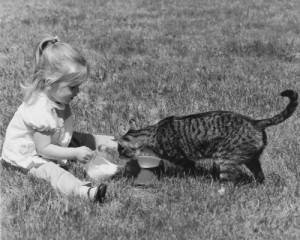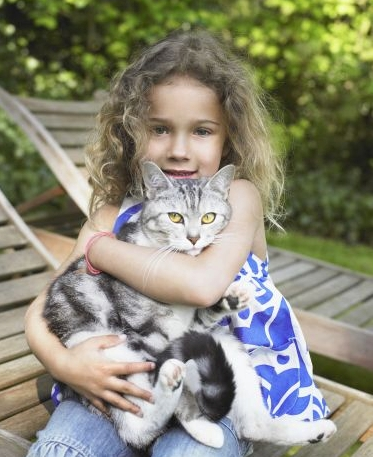Q: I’m currently pregnant and the baby is due in May of next year. I have five cats. Two of them will be about a year and a half when the baby is born. The other three are 11, 11, and 5. Should I be concerned about behavioral changes? What should I keep an eye out for? If issues arises, what do you recommend? I really would prefer to keep the cats as they are very beloved and otherwise well behaved. – Esther

A: There is no reason to get rid of the kitties because you have a baby and there are many things you can do. Desensitizing the kitties to the baby before the baby arrives, as well as any changes in routine, will be helpful, such as softly playing CDs of human baby noises and crying, and exposing your kitties to strollers, rattles, baby powder scented or laundered items, and so on. Desensitizing means gradually exposing your kitties to what may stress them at levels that aren’t stressful. This will vary with each individual cat. In other words, go at their pace, so that they always feel content and comfortable before moving on to more exposure.
The crib may potentially be a comfy place that may be enticing to a few of your cats. If your kitty goes in the crib, simply remove your kitty gently and unemotionally without making eye contact, and place your kitty on the floor or on an alternate surface. Then walk away, or continue to do what it was you were previously doing. You may have to do this numerous times, but eventually your kitty will choose another location to lie in. I prefer this method. If you do this well in advance of the baby coming, your kitties should acclimate rather well. In general, many cats tend to dislike the crib once the baby is associated with it. Often, because the baby cries in the crib and they associate the crib and/or the crib’s location with loud noise or diaper changes.
It is important to increase vertical territory for your cats, especially since your baby when s/he becomes a toddler will spend quite a bit of time on the floor. Cat condos, window perches, warm fleece beds on table tops, and so on, will let your kitties be in the same room as your baby, but provide them their own personal space and some distance.
You should not alienate your cats by teaching them to avoid the baby. They should always have a positive association with the baby. In general, newborn infants do not cause a problem for most animals. It is when the child begins to crawl and/or walk. Often this is where behaviors of toddlers go unmanaged, animals become swing toys, rag dolls, or worse, and adults tend to ignore the animals in the household, scapegoat them, or there is lack of supervision over the toddlers.

Young children and toddlers can absolutely be taught to be gentle with animals. In child psychology, it has been shown that children, including small infants, mimic or copy the behaviors of adults. Most animals learn through observation of parents, adult animals, or siblings.
Here’s what you can do:
Begin by teaching your baby to gently pet animals with an open hand, instead of grabbing. To do this, hold your infant’s hand open in yours, while spreading his/her fingers, so that your child’s hand is flat. With your hand holding and guiding your child’s, gently guide your baby’s hand over your kitty’s fur, along his/her back. Do this very softly, so that your child learns how to ‘pet’ your kitty gently. Only do this when your kitty is relaxed, and do not bring your child’s hand directly over your kitty’s head or towards your kitty’s face.
When your child is present, it is important that you exaggerate gentle manners and behaviors around your kitties. This also includes your voice. What may look to us as fun ‘scruffles,’ gentle petting, and ‘smoochy’ kisses, or gentle holding, to your child can look like vigorous patting or hitting, hugging and restraining, or ‘grabbing’ fur. Human toddlers do not initially have the motor skills or coordination to open their palms when they pet an animal or to control how hard or quickly they pet an animal.
In addition, teach your child this nursery rhyme (It’s quite catchy and easy for children to memorize. My mother taught this very nursery rhyme to me as a little girl.):
“I know a little kitty. Her coat (or fur) is so warm.
And if I don’t hurt her, she’ll do me no harm.
So I won’t pull her tail or drive her away.
And kitty and I very gently will play.”
Lastly, it’s hard to predict changes. Since you have two very young cats, it will be important to give them quality play time. See How to Play with Your Kitty.
Copyright © Alana Stevenson 2013
Alana Stevenson can be contacted through her website AlanaStevenson.com. She provides behavioral consultations by phone and Skype.